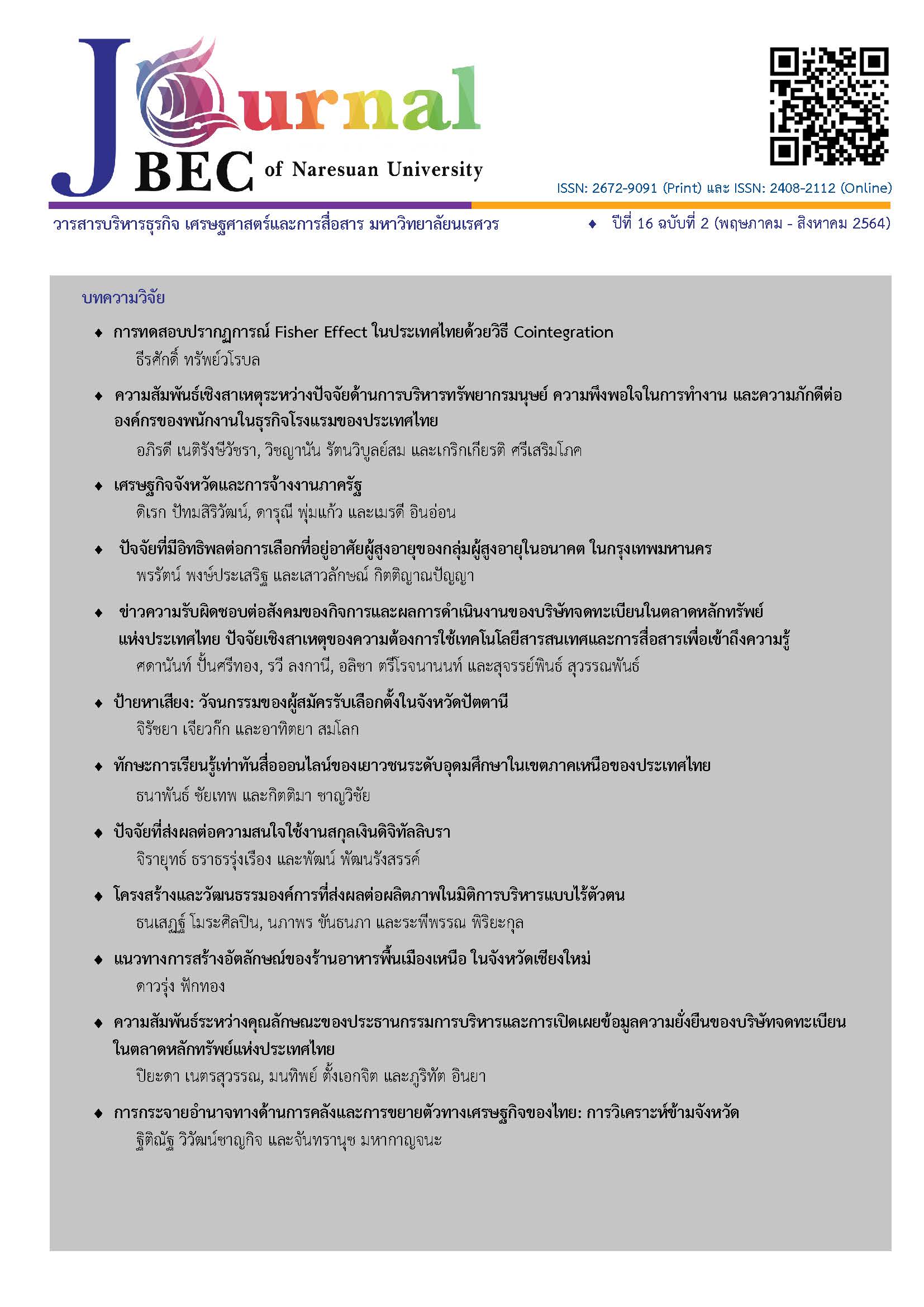โครงสร้างและวัฒนธรรมองค์การที่ส่งผลต่อผลิตภาพในมิติการบริหารแบบไร้ตัวตน
Main Article Content
บทคัดย่อ
การบริหารแบบไร้ตัวตนเป็นรูปแบบการบริหารที่เกิดจากการเปลี่ยนแปลงอย่างเป็นพลวัตรและรวดเร็วของปัจจัยภายนอกและภายใน หากองค์การไม่ปรับรูปแบบบริหารจะส่งผลต่อผลิตภาพ จึงเป็นประเด็นนำมาสู่การศึกษาจากตัวอย่างบุคลากรจำนวน 300 หน่วย ที่ทำงานในองค์การที่มีลักษณะการบริหารแบบไร้ตัวตน เพื่อนำมาใช้ในการวิเคราะห์ตัวแบบเชิงยืนยันที่สังเคราะห์จากวรรณกรรม ตัวแบบมีโครงสร้างและวัฒนธรรมองค์การเป็นปัจจัยขับเคลื่อนผ่านปัจจัยคั่นกลางคือ การจัดการพื้นที่ทำงานแบบไร้ตัวตน ภาวะงานไร้ความคลุมเครือ และความมีประสิทธิภาพของปฏิบัติภารกิจมากกว่าหนึ่ง ผลการศึกษาพบว่า โครงสร้างองค์การแบบไร้ตัวตน มีอิทธิพลรวมต่อผลิตภาพขององค์การสูงถึง 0.676 อย่างมีนัยสำคัญ ในการทดสอบปัจจัยส่งผ่าน พบว่า ภาวะงานไร้ความคลุมเครือ เป็นปัจจัยส่งผ่าน ระหว่าง ปัจจัยวัฒนธรรมองค์การแบบไร้ตัวตนกับปัจจัยความมีประสิทธิภาพของปฏิบัติภารกิจมากกว่าหนึ่ง
Article Details
เอกสารอ้างอิง
Anyanwu, C. M. (2000). Productivity in The Nigerian Manufacturing Industry. Retrieved 20 May 2020, from https://www.cbn.gov.ng/
Bass, B. M. (1985). Leadership: good, better, best. Organizational Dynamics, 13(3), 25-40.
Bennett, J., Owers, M., Pitt, M., and Tucker, M. (2010). Workplace impact of social networking. Property Management, 28(3), 138-148.
Brake, T. (2006). Leading global virtual teams. Industrial and Commercial Training, 38(3), 116-121.
Cascio, W. (2000). Managing a virtual workplace. Academy of Management Perspectives, 14(3), 81-90.
Chang, J. (2013). Strengthening Value Innovation Potential-A Study of Innovation- Oriented Industry in Taiwan. International Journal of Advancements In Computing Technology, 5(4), 882-889. doi: 10.4156/ ijact.vol5.issue4.106
Chaturvedula, S., Shruti, R., and Murthy, R. (2019). Impact of Tolerance of Ambiguity on Job Performance, Creativity and Decision-making Styles: A study on Indian Software professionals. International Journal for Innovative Research in Multidisciplinary Field, 3(3), 102-112.
Chungade, T., and Kharat, S. (2016). A Review of Performance Assessment in Virtual Organization using Domain-Driven Data Mining and Sentiment Analysis. International Journal of Innovative Research, 4(12).
Cisco. (2014). Cisco Connected World Technology Report [Ebook]. Retrieved from https://www.cisco.com/c/dam/en/ us/solutions/collateral/enterprise/connected-world-technology-report/ccwtr-press-deck.pdf
Colbert, A., Yee, N., & George, G. (2016). The Digital Workforce and the Workplace of the Future. Academy Of Management Journal, 59(3), 731-739.
Cooper, C., and Straw, A. (1998). Successful stress management in a week. Sevenoaks: Headway.
Čulo, K. (2016). Virtual Organization-The future has already begun. Media, Culture And Public Relations, 7(1), 35-42. Retrieved from https://hrcak.srce. hr/file/235845
Edwards, J., and Shipp, A. (2007). The relationship between person-environment fit and outcomes: An integrative theoretical framework. Retrieved from https://pdfs. semanticscholar.org/3bb6/116e4b69e2536563574ce3cc57889e4f1149.pdf
Eng, T. (2008). The Effects of the Internet on Network Structures and Business Performance. Electronic Markets, 18(1), 91-101.
Farmer, N. (2016). The invisible organization. New York: Routledge.
Fernandez, S., and Moldogaziev, T. (2013). Employee Empowerment and Job Satisfaction in the U.S. Federal Bureaucracy. The American Review of Public Administration, 45(4), 375-401. doi: 10.1177/0275074013507478
Gaudes, A., Bonnie, H., Marsh, S., and Robinson, H. (2007). A Framework for Constructing Effective Virtual Teams. The Journal of E-Working, 1, 83-97.
Gupta, K. (2016). You’re Not Multitasking; Why Switch-Tasking Is Ruining Your Productivity. Retrieved 2 January 2020, from https://polar.me/blog/youre-not-multitasking-switch-tasking-ruining-productivity/
Haag, S., and Cummings, M. (2013). Management information systems for the information age. New York, NY: McGraw-Hill Irwin.
Hair, J. F., Black, W. C., Babin, J., Anderson, R. E., & Tatham, R. L. (2006). Multivariate data analysis (6 ed.). Upper Saddle River, NJ : Prentice-Hall.
Kanawattanachai, P., and Yoo, Y. (2002). Dynamic nature of trust in virtual teams. The Journal of Strategic Information Systems, 11(3-4), 187-213.
Khorasani, S., & Almasifard, M. (2017). Evolution of Management Theory within 20 Century: A Systemic Overview of Paradigm Shifts in Management. International Review Of Management And Marketing, 7(3), 134-137. Retrieved from https://www.econjournals.com/index.php/irmm/article/view/4719/pdf
Kolkitchaiwan, P., and Chantuk, T. (2018). Journal of Pacific Institute of Management Science, 4(1), 334.
Kumar, A. (2000). A review and analysis of the state-of-the-art research on productivity measurement. Industrial Management and Data Systems, 100, 234-41.
Mathis, R., and Jackson, J. (2000). Human resource management (9th ed.). Ohio: South Western College.
McDowell, T., & Anderson, S. (2019). Making the invisible visible. Retrieved 27 August 2019, from https://www2.deloitte.com/us/en/insights/focus/technology-and-the-future-of-work/organizational-network-analysis-network-of-teams.html
McKeown, M. (2010). Truth About Innovation. Pearson Business.
O'Reilly, C., Caldwell, D., Doerr, B., and Chatman, J. (2014). Parsing organizational culture: How the norm for adaptability influences the relationship between culture consensus and financial performance in high-technology firms. Journal of Organizational Behavior, 35(6), 785-808.
Pedersen, C., and Nagengast, J. (2008). The virtues of the virtual organization. Strategic HR Review, 7(3), 19-25.
Prasad, K., & Akhilesh, K. (2002). Global virtual teams: what impacts their design and performance? Team Performance Management: An International Journal, 8(5/6), 102-112. doi: 10.1108/13527590210442212
Porter, M. (1985). Competitive advantage. NY: The Free Press.
Pisano, G. (2019). About Innovative Cultures. Harvard Business Review, (January-February), 62-71. Retrieved from https://hbr.org/product/harvard-business-review-january-february-2019/BR1901-MAG-ENG
Robbins, S., & Coulter, M. (2012). Management (11th ed., pp. 286-301,51-58). Boston: Prentice Hall.Russo, M. (2015). The Invisible Organization: How Ingenious CEOs Are Creating Thriving, Virtual Companies. Best Seller Publishing.
Schermerhorn, J., Osborn, R., and Hunt, J. (2002). Organizational behavior. [Phoenix]: University of Phoenix.
Stanton, J., M. (2001). Galton, Pearson, and the Peas: A Brief History of Linear Regression for Statistics Instructors. Journal of Statistics Education, 9(3).
Syverson, C. (2011). What Determines Productivity? Journal of Economic Literature, 49(2), 326–365
Travica, B. (1997). The Design of the Virtual Organization: A Research Model. In Americas Conference on Information Systems. AIS Electronic Library. Retrieved from https://aisel.aisnet.org/ amcis1997/?utm_source=aisel.aisnet.org%2Famcis1997%2F270&utm_medium =PDF&utm_campaign=PDFCoverPages
Vieira, A. L. (2011). Interactive LISREL in practice. New York, NY: Springer.
Vlad. (2018). Cognizant Softvision - Multitasking: A Good or Bad Thing to Do?. Retrieved 31 December 2019, from https://www.cognizantsoftvision. com/blog/ multitasking-a-good-or-bad-thing-to-do/
Walker, L. (2010). The N.O. L.I.M.I.T.S. approach to virtual team projects. Presentation, https://www.pmi.org/learning/library/leadership-tools-virtual-project-teams-6613.
Walters, D., and Buchanan, J. (2001). The new economy, new opportunities and new structures. Management Decision, 39(10), 818-834.
Watson, J., and Strayer, D. (2010). Supertaskers: Profiles in extraordinary multitasking ability. Psychonomic Bulletin & Review, 17(4), 479-485.
Williams, S., & Schubert, P. (2018). Designs for the Digital Workplace. Procedia Computer Science, 138, 478-485.
World Economic Forum. (2019). Employment Trends. Retrieved 24 September 2019, from http://reports.weforum.org/future -of-jobs-2016/employment-trends/
Zehra, A. (2014). New Organization Structures: Virtual Organizations. International Journal of Engineering and Applied Sciences, 6(2), 18-27.


